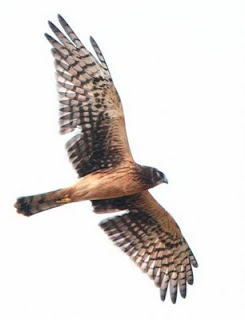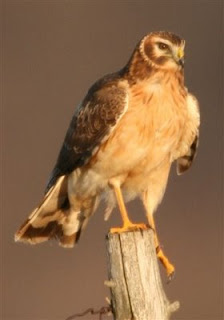_Harrier,Northern_MAC_(c)DaveSpier.jpg)
© Dave Spier
At this rate, it just might spend the winter here. Sometimes it flies close to the building, passing the west windows, and then disappears across the field. I doubt it's hunting the birds at the feeder, but they are within the realm of this raptor's diet. Mostly it flies low over the grasslands and the marsh while it looks for small mammals, especially Meadow Voles (also called field mice) which are caught with a sudden pounce. Sometimes this large bird's flight drifts lazily back and forth, then stops momentarily to hover. In warmer weather it hunts snakes, frogs and insects. When all else fails, carrion is eaten.
The Northern Harrier, once known as the marsh hawk, is a slender and buoyant hawk with a somewhat owl-like face. The hawk's long wings and tail are designed for life in the open. If it tips a bit sideways toward you, watch for the distinctive white rump patch. When soaring, the wings are held in a shallow V with the tail fanned. At low altitudes, the tail is usually closed and the wings held flat to the sides. In a steep glide, the wings are sharply bent and swept back like a fighter jet.
In the winter, harriers hang around with Short-eared Owls and share the same fallow, grassy fields where mice have had time for a population explosion. Both raptors will use fence posts as hunting perches while they listen for prey. Though unrelated, the facial disks of both harriers and owls are thought to help focus sounds on the ears.
The harrier's Latin name, Circus cyaneus, refers to its circling flight and the supposedly blue plumage of the males. The color is actually gray, but that's only half accurate because females and juveniles are brown, an unusual disparity for raptors. Juvenile harriers are orangish underneath, like the two photos. The name "harrier" is Old English for "harassing with hostile attacks." Other colloquial names include blue hawk, mouse hawk and white-rumped hawk. Males are smaller and more agile and catch smaller prey, including birds. The harrier flying past the Montezuma Audubon Center (Rt. 89, Savannah, NY) was a larger, brown female probably more intent on a larger meal than the tiny goldfinches at the feeder.
Harriers nest in the marshes at Montezuma National Wildlife Refuge (between Rochester and Syracuse, NY). Last April I watched a female repeatedly carry nesting material in her beak and then drop down into the same patch of heavy vegetation. There are indications harriers also may nest in the Northern Montezuma Wetlands Complex around Savannah (Wayne County, NY). They almost certainly nest in the Lakeshore Marshes Wildlife Management Area near Lake Ontario in northeastern Wayne County as well as Howland's Island in Cayuga County. The female does all the incubating while the male brings food. After the eggs hatch, the male continues supplying prey, but only the female tears it up and feeds the young. If something happens to her, the nestlings will starve, even though the male continues to drop whole prey into the nest.
Harriers breed from Alaska across Canada to the Maritimes and south into the United States as far as a line from California to Pennsylvania. Most harriers head south for the winter and return in the spring.
Contact me at northeastnaturalist@yahoo.com More nature photos can be seen at http://picasaweb.google.com/northeastnaturalist and http://www.flickr.com/photos/dave_spier and now my Facebook photo page.
(This copyrighted article - slightly revised here - and photos first appeared in the Times of Wayne County, November 24, 2008. All rights reserved.)
_Harrier,Northern_NY_Mar11_(c)DaveSpier.jpg)
DaveSpier_D014784e.jpg)